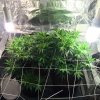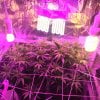I'm gonna go get giant aluminum reflectors from home Depot for my cfl Chandeliers tomorrow.
Another option is GE 10w (60w equiv) LED BrightStik. They cost only $3.50.
I usually use Cree 9.5w LED lightbulbs. They're omnidirectional and maybe 30% more lumens/w than a CFL. But, the GE BrightStick has the LEDs flush-mounted to the base (they all point forward). So, they are directional even without a reflector(!)
From my test yesterday:
GE 10w (60w equiv) BrightStik (warm)
No reflector: 860 lux
Reflector: 1200 lux
Generic 15w (60w equiv) CFL (warm)
No reflector: 180 lux
Reflector: 725 lux
As you can see, the GE 10w (without a reflector) is brighter than the 15w CFL
in a reflector. (If you add a reflector, it's 6.6x brighter than a CFL without a reflector).
My test isn't quite as clear-cut as that. I didn't measure distribution across a 2-foot square. I only measured directly in front of the bulb (maybe 20" distance). There could be coverage differences (the intensity at 6 or 12" off center). My smartphone app to measure lux isn't that good (the sensor on my phone isn't that good).
In the past the downside to LED lightbulbs (compared to CFL) was the price. But, the 10w GE BrightStik is $3.50 at Home Depot.
I'm using
one bulb now. @
zachyweezer88 is
beginning to grow with them (maybe CFL and GE mixed together?).
GE just relased a 16w (100w equiv) version. It's only sold at Sams Club at the moment. It looks like it could be even more efficient. (The lumens/watts on the box don't look that good. But, it is the forward-facing diodes which make these lights really good. They're already directional. Less loss is incurred from reflecting the light.). I've got one and will post more about it in
this article.
Now for a word of caution:
To get the goodness of that GE bulb, you have to remove the plastic diffusion cap.
This teardown has photos showing what it looks like. This expose line voltage. If recessed in a clamp-on reflector, there's not much risk of contact. But, still, it's potentially lethal.
To be
perfectly safe, you should power these through a GFI outlet (just make an extension cord with an junction box at the end, and a GFI outlet. Or, replace the wall outlet with a GFI).
Removing the cap:
I grasp the base and cap, and try to break it in half. I rotate it in my hands, trying to break it in half. After 3-4 tries, it breaks.
However, one time the diode plate came off with the cap. It slides back onto the two prongs (seen in the teardown link).
It may be better to hacksaw around the base to remove the cap. But, don't cut too deeply. You don't want to hit anything.
Storage:
With the cap removed, the phosphor (yellow) coating on the diodes is subject to damage. They should be handled and stored carefully. (If the phosphors are scraped off, it will change the light spectrum.).
The 3-pack box they come in is a good way to store them. Or, use 8oz solo (party) cups (face down into the cup, a rubber band to hold the cup to the light's base.).


